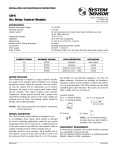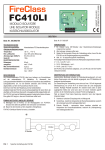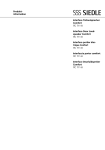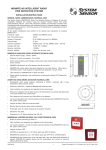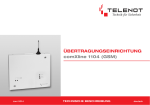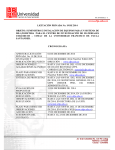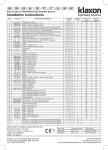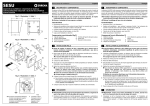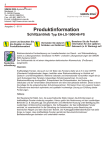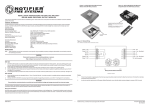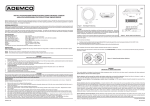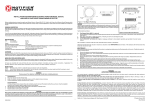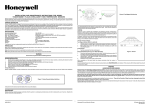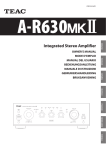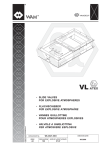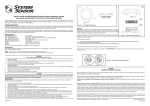Download Descargar
Transcript
by Honeywell MI-IM10 Ten Input Monitor Module Morley IAS Fire Systems Charles Avenue, Burgess Hill, West Sussex, RH15 9U SPECIFICATIONS Normal Operating Voltage: Stand-By Current: Alarm Current: Temperature Range: Humidity: Dimensions: Accessories: Wire Gauge: Maximum SLC Wiring Resistance: Maximum IDC Wiring Resistance: Maximum IDC Voltage: Maximum IDC Current: 15-32 VDC 3.5 mA 60 mA (assumes all ten LEDs solid on) –10°C to 55°C 10 to 93% Non-condensing 17.3cm H x 14.7cm W x 3.2cm D Suitably grounded metallic cabinet 0.9mm2 - 3.25mm2 40 Ohms 40 Ohms 12 VDC 1 mA BEFORE INSTALLING COMPATIBILITY REQUIREMENTS This information is included as a quick reference installation guide. Refer to the appropriate control panel installation manual for detailed system information. If the modules will be installed in an existing operational system, inform the operator and local authority that the system will be temporarily out of service. Disconnect the power to the control panel before installing the modules. This system contains static sensitive components. Always ground yourself with a proper wrist strap before handling any circuits so that static charges are removed from the body. The housing cabinet should be metallic and suitably grounded. To ensure proper operation, this module shall be connected to a listed compatible system control panel. The MI-IM10 Module shall be mounted in a suitably grounded Metallic Cabinet for EMC compliance. WIRING NOTE: All wiring must conform to applicable local codes, ordinances, and regulations. 1.Install module wiring in accordance with the job drawings and appropriate wiring diagrams. 2.All wiring to the MI-IM10 is done via terminal blocks. In order to properly make electrical connections strip approximately .6 cm of insulation from the end of wire, sliding the bare end of the wire under the clamping plate screw. 3.Set the address on the modules per the job drawing. Use the rotary code switches to set the address of the first module (between 01 and 90). NOTICE: This manual should be left with the owner/user of this equipment. GENERAL DESCRIPTION The MI-IM10 Ten Input Monitor Module is intended for use in an intelligent alarm system. Each monitor module is intended to interface between a control panel and normally open contact devices, such as pull stations. A common SLC input is used for all modules, and the initiating device loops share a common supervisory supply and ground. Otherwise, each monitor operates independently from the others. Each module has its own unique address. The remaining modules are automatically assigned to the next nine higher addresses. For example, if the base address switch is set to 28, the next nine modules will be addressed to 29, 30, 31, 32, 33, 34, 35, 36, and 37. A pair of rotary code switches is used to set the address of the first module from 01 to 90. The remaining modules are automatically assigned to the next nine higher addresses. Provisions are included for disabling a maximum of two unused modules to release the addresses to be used elsewhere. Each module also has panel controlled green LED indicators. The panel can cause the LEDs to blink, latch on, or latch off. DO NOT set the lowest address above 90, as the other modules will be assigned to nonexistent addresses. 4.A shunt is provided to disable a maximum of two unused modules. Modules are disabled from the highest address and work downward. If two modules are disabled, the lowest eight addresses will be functional, while the highest two will be disabled. For example, if the shunt for Address Disable is placed on “two” and the base switch is set to 28, the modules will be assigned to 28, 29, 30, 31, 32, 33, 34 and 35 while disabling the highest two positions. Included: (6) 1 × 4 Terminal Blocks (2) 3.2 cm Stand offs (2) Nuts NOTE: Place unused shunts on single pin to store on board for future use. (3) Small Shunts (4) Screws (10) 47k Ohm End of Line Resistors Shipped on Board: C0906-00 (1) Shunt M450-02-000 1 I56-2957-000 I56-2957-000 INSTALLATION AND MAINTENANCE INSTRUCTIONS ADDRESS 5 4 3 2 10 IDC +9 + — BASE ADDRESS 6789 ADDRESS IDC ADDRESS ADDRESS IDC ADDRESS IDC + STATUS INDICATORS SLC + — TO NEXT DEVICE + – + – — FROM PANEL OR PREVIOUS DEVICE A/B SLCT COM LOSS DISABLE 1 DISABLE 2 — POWER LIMITED AND SUPERVISED + — + +1 +0 CLASS B IDC (TYPICAL) — + — + +3 +2 — +4 + — +5 47K EOL RESISTOR 6789 5 4 3 2 10 IDC + — +6 + — +7 + — +8 CONNECT MODULES TO LISTED COMPATIBLE CONTROL PANELS ONLY + Figure 1. Typical Initiating Device Circuit Configuration: COMMUNICATION LINE 32 VDC MAX. TWISTED PAIR IS RECOMMENDED. C0207-00 NOTE: DO NOT mix fire alarm initiating and supervisory devices on the same initiating device circuit. Install contact closure devices per manufacturer’s installation instructions. M450-02-000 2 I56-2957-000 ISTRUZIONI DI INSTALLAZIONE E MANUTENZIONE by Honeywell MI-IM10 Modulo di ingresso a dieci canali Morley IAS Fire Systems Via Grandi 22 S. Donato Milanese, Milano, Italia SPECIFICHE Normale tensione di esercizio: Corrente in stand-by: Corrente di allarme: Range di temperatura: Umidità: Dimensioni: Accessori: Sezione conduttori: Massima resistenza del cablaggio SLC: Massima resistenza del cablaggio IDC: Massima tensione IDC: Massima corrente IDC: 15 - 32 VDC 3.5 mA 60 mA (a condizione che tutti i dieci LED siano accesi in modo fisso) da -10°C a 55°C dal 10 all’93% senza formazione di condensa; A 173 mm x L 147 mm x P 25 mm cabinet metallico dotato di un’adeguata messa a terra 0.9 mm² - 3.25 mm² 40 ohm 40 ohm 12 VDC 1 mA Accessori in dotazione: PRIMA DELL’INSTALLAZIONE Le informazioni qui riportate fungono da guida all’installazione di consultazione rapida. Per informazioni dettagliate sul sistema, consultare il manuale di installazione del pannello di controllo. In caso di installazione dei moduli in un sistema operativo già funzionante, informare l’operatore e le autorità locali che il sistema rimarrà temporaneamente fuori servizio. Prima di installare i moduli, scollegare l’alimentazione del pannello di controllo. Il sistema contiene componenti sensibili all’elettricità staticà. Prima di maneggiare qualsiasi tipo di circuito, collegarsi sempre a massa utilizzando un’apposita fascia che respinge le cariche statiche dal corpo. È importante che la struttura del cabinet sia metallica e adeguatamente collegata a massa. (6) 1 × 4 Morsettiera (2) Dadi (3) Derivazione (4) Viti (10) Resistori di fine linea da 47k Ohm Elementi a bordo scheda: C0906-00 (1) Derivazione REQUISITI DI COMPATIBILITÀ AVVISO: Il presente manuale deve essere consegnato al proprietario/all’utente di questo apparecchio. Per garantire il corretto funzionamento, collegare questo modulo al pannello di controllo di un sistema compatibile elencato. Il modulo MI-IM10 deve essere montato all’interno di un contenitore metallico collegato a massa per incontrare i requisiti di compatibilità elettromagnetica. DESCRIZIONE GENERALE Il modulo per monitor a dieci ingressi MI-IM10 è stato progettato per l’uso in sistemi d’allarme intelligenti. Ogni ingresso è stato progettato per fungere da interfaccia tra un pannello di controllo e dispositivi con contatti normalmente aperti, quali postazioni di allarme comandate con maniglia di trazione. IL modulo utilizza un tradizionale ingresso SLC e i loop del dispositivo di attivazione condividono la stessa alimentazione di supervisione e la stessa messa a terra. In caso contrario, ciascun ingresso funzionerebbe indipendentemente dagli altri. Ogni modulo possiede un proprio indirizzo distintivo. CABLAGGIO NOTA: l’intero cablaggio deve essere conforme a tutte le normative, ordinanze e disposizioni locali vigenti. 1.Installare il cablaggio del modulo conformemente ai diagrammi di lavoro e ai relativi schemi di cablaggio. 2.L’intero cablaggio del MI-IM10 passa attraverso delle morsettiere. Per eseguire in modo corretto le connessioni elettriche rimuovere circa 5mm di materiale isolante dall’estremità del filo e far passare l’estremità scoperta del filo sotto la piastra di fissaggio e serrarne la vite. 3.Impostare l’indirizzo dei moduli secondo il diagramma di lavoro. Per impostare l’indirizzo del primo modulo (valore compreso tra 01 e 90) utilizzare gli switch con codice a rotazione. Per impostare l’indirizzo del primo modulo su un valore compreso tra 01 e 90, utilizzare la coppia di switch con codice a rotazione. Ai restanti moduli vengono assegnati automaticamente i nove successivi indirizzi più alti. La disabilitazione di un massimo di due moduli non utilizzati è regolata da particolari disposizioni che consentono di riutilizzare altrove questi indirizzi. Ogni modulo dispone anche di indicatori LED di colore verde controllati dal pannello. A seconda delle istruzioni del pannello, i LED possono lampeggiare, essere attivati oppure disattivati. M450-02-000 (2) Stand offs da 32mm Ai restanti moduli vengono automaticamente assegnati i nove successivi indirizzi più alti. Se ad esempio l’indirizzo dello switch di riferimento è impostato su 28, ai nove moduli successivi verranno assegnati gli indirizzi 29, 30, 31, 32, 33, 34, 35, 36 e 37. 3 I56-2957-000 NON impostare l’indirizzo più basso su un valore superiore a 90, poiché agli altri moduli verrebbero assegnati indirizzi inesistenti. 4.Per disabilitare un massimo di tre moduli non utilizzati è disponibile una derivazione. I moduli vengono disabilitati a partire da quello con l’indirizzo più alto e funzionano verso il basso. Se vengono disabilitati due moduli, i quattro moduli con l’indirizzo più basso rimarranno funzionanti mentre i due con l’indirizzo più alto verranno disabilitati. Se ad esempio la derivazione per la disabilitazione dell’indirizzo si trova su “due” e l’indirizzo dello switch di riferimento è impostato su 28, ai moduli verranno assegnati gli indirizzi 28, 29, 30 e 31, mentre le due posizioni più alte verranno disabilitate. NOTA: Posizionare le derivazioni inutilizzate su un singolo pin in modo che possano essere conservate per usi futuri. Figura 1. Tipica configurazione : IDC + +9 + — 6789 5 4 3 2 10 + +7 + — +6 IDC — + +5 NDIRIZZO + — +4 — + — + +3 NDIRIZZO +2 IDC — + INDICATORI DI STATO SLC + — AL DISPOSITIVO SUCCESSIVO + – + – — DAL PANNELLO O DAL DISPOSITIVO PRECEDENTE SLZN A/B PERDITA DI COM. DISABILITA 1 DISABILITA 2 — CON LIMITAZIONE DELLA POTENZA E SUPERVISIONE + — + +1 NDIRIZZO +0 IDC IDC CLASSE B (TIPICO) 6789 5 4 3 2 10 IDC 47K RESISTORE DI FINE LINEA NDIRIZZO — +8 NDIRIZZO INDIRIZZO DI RIFERIMENTO COLLEGARE I MODULI SOLO AI PANNELLI DI CONTROLLO COMPATIBILI ELENCATI LINEA DI COMUNICAZIONE MAX. 32 VDC SI CONSIGLIA UN CAVO TWISTED PAIR. C0283-00 NOTA: NON installare dispositivi di attivazione dell’allarme antincendio e dispositivi di supervisione nel circuito dello stesso dispositivo di attivazione. Installare i dispositivi di chiusura dei contatti conformemente alle istruzioni di installazione del produttore. M450-02-000 4 I56-2957-000 INSTRUCCIONES DE INSTALACIÓN Y MANTENIMIENTO by Honeywell MI-IM10 Módulo Monitor con diez circuitos de entrada Morley IAS Fire Systems C/Ávila 25 San Sebastián de los Reyes, 28700 Madrid, Espana ESPECIFICACIONES Tensión de Funcionamiento Normal: Corriente en reposo: Corriente en Alarma: Rango de temperatura: Humedad: Dimensiones (mm): Accesorios: Sección del Cable: Resistencia máxima del lazo analógico: Resistencia máxima del lazo del circuito de entrada: Tensión máxima del circuito de entrada: Corriente máxima del circuito de entrada: 15-32 VDC 3,5 mA 60 mA (asumiendo que los diez leds están iluminados de forma fija) de –10°C a 55°C Del 10 al 93% No condensada 185 (alto) x 147 (ancho) x 25 (fondo) Cabina metálica conectada adecuadamente a tierra 0,9mm² - 3,25mm² 40 Ohmios 40 Ohmios 12 VDC 1 mA ANTES DE LA INSTALACIÓN Piezas incluidas: Esta información se utiliza como guía rápida para la instalación. Consulte el manual de instalación correspondiente al panel de control para obtener información detallada sobre el sistema. Si los módulos se van a instalar en un sistema operativo ya existente, informe al usuario y a la autoridad local de que dicho sistema estará temporalmente fuera de servicio. Desconecte la alimentación antes de instalar los módulos. Este sistema contiene componentes sensibles a la electricidad estática. Utilice una pulsera de conexión a tierra para manipular los circuitos de modo que se eliminen las cargas estáticas. La carcasa del módulo también debe estar conectada a tierra. (6) 1 × 4 Bloques de terminales (2) Tuercas (2) Puentes (4) Tornillos (10) Resistencia de fin de línea de 47k Ohmios Elementos integrados: AVISO: Este manual debe permanecer al alcance del propietario/ usuario del equipo. (1) Puente C0906-00 COMPATIBILIDAD DESCRIPCIÓN GENERAL Para asegurar un funcionamiento adecuado, conecte este módulo sólo a un panel de control compatible. El MI-IM10 debe montarse en una cabina metálica conectada ade-cuadamente a tierra para cumplir con la directiva de compatibilidad electromagnética (CEM) El Módulo Monitor MI-IM10 ha sido diseñado para su uso en un sistema de alarma inteligente. Cada módulo sirve para interconectarse con un panel de control y dispositivos de contacto normalmente abierto, como pulsadores manuales. Para todos los módulos se utiliza una entrada de lazo SLC común, y los bucles de equipos de iniciación comparten una fuente de alimentación supervisada y la toma de tierra. De lo contrario, cada monitor funciona independientemente de los otros. Cada módulo tiene su propia dirección. Para configurar la dirección del primer módulo de 01 a 90, se utiliza el par de selectores rotatorios. Al resto de los módulos se les asignarán automáticamente las siguientes nueve direcciones numéricas. Se incluye la posibilidad de desactivar un máximo de dos módulos no utilizados, cuyas direcciones se pueden liberar y utilizar en otro lugar. Cada módulo dispone también de leds indicadores verdes controlados desde el panel. Desde el panel se puede hacer que estos leds parpadeen, se mantengan iluminados de forma fija o se apaguen. M450-02-000 (2) Separadores de 32mm CABLEADO NOTA: Todos los cables deben ajustarse a los códigos, ordenanzas y regulaciones locales. 1.Instale el cable del módulo según los dibujos y diagramas correspondientes. 2.Todo el cableado del MI-IM10 se efectúa mediante bloques de terminales. Efectúe las conexiones eléctricas pelando unos 5 mm del aislante del cable, a continuación, coloque el cable pelado debajo del tornillo y enrosque el tornillo. 3.Ajuste la dirección en los módulos según el dibujo. Utilice los selectores rotatorios para configurar la dirección del primer módulo (entre 01 y 90). Al resto de los módulos se les asignarán automáticamente las nueve direcciones siguientes. Por ejemplo, si la dirección base se ajusta con el número 28, a los siguientes nueve módulos se les adjudicarán las direcciones 29, 30, 31, 32, 33, 34, 35, 36 y 37. 5 I56-2957-000 NO debe configurar la dirección más baja por encima del número 90, ya que al resto de módulos se les adjudicarían direcciones que no existen. 4.Se proporciona un puente para anular un máximo de dos módulos no utilizados. Estos módulos se anulan empezando por la dirección más alta. Si se anulan dos módulos, estarán operativas las ocho direcciones inferiores, mientras que quedarán anuladas las dos más altas. Por ejemplo, para funcionamiento en clase B, si el puente de anular dirección se pone en “dos” y la dirección base se ajusta a 28, se adjudicarán a los módulos los números 28, 29, 30, 31, 32, 33, 34 y 35, mientras que quedarán anuladas las dos posiciones más altas (36, 37). NOTA: Guarde los puentes no utilizados para un posible uso en el futuro. +9 — + DIRECCIÓN +8 IDC — + — + +7 +6 IDC — + + +5 — +4 IDC — +3 — + DIRECCIÓN +2 — + IDC +1 — + DIRECCIÓN +0 IDC INDICADORES DE ESTADO + — — AL DISPOSITIVO SIGUIENTE + – + – SELECCIÓN A/B PÉRDIDA COMUNICACIONES ANULAR 1 ANULAR 2 + — + TENSIÓN LIMITADA Y SUPERVISADA SLC CLASE B IDC (TÍPICO) DESDE EL PANEL O DISPOSITIVO ANTERIOR 6789 5 4 3 2 10 + RESISTENCIA FINAL DE LÍNEA 47K DIRECCIÓN BASE 6789 5 4 3 2 10 DIRECCIÓN LOS MÓDULOS SÓLO SE DEBEN CONECTAR A PANELES DE CONTROL COMPATIBLES DIRECCIÓN Figura 1. Ejemplo de configuración típica de un circuito de iniciación: LÍNEA DE COMUNICACIONES 32VDC MAX. SE RECOMIENDA CABLE TRENZADO. C0284-00 NOTA: NO mezcle equipos de iniciación de alarmas de incendio y de supervisión en el mismo circuito de iniciación. Instale los equipos de cierre de contacto M450-02-000 6 ©2006 System Sensor I56-2957-000 INSTALLATIONS UND WARTUNGSANLEITUNG by Honeywell MI-IM10 Zehn-Eingangsmodul, überwacht Morley IAS Berliner strasse 91 40880 Ratingen, Germany SPEZIFIKATION Betriebsspannungsbereich: Ruhestrom: Alarmstrom: Temperaturbereich: Luftfeuchte: Abmessungen: Zubehör: Kabelquerschnitt: Maximale Ringbus-Anschlussimpedanz: Maximale IDC Anschluss Impedanz: Maximale IDC Spannung: Maximaler IDC Strom : 15-32 VDC 3,5 mA 60 mA (bei 10 dauerleuchtenden LED) –10°C to 55°C 10 bis 93% ohne Betauung 173 x 147 x 25 (H x B x T in mm) geerdetes Metallgehäuse 0,9mm2 – 3,25mm² 40 Ohm 40 Ohm 12 VDC 1 mA Im Lieferumfang enthalten: VOR DER INSTALLATION Diese Information dient als Kurzanleitung für die Installation. (6) 1 × 4 Anschlussklemmen (2) 32mm Abstandshalter Wenn Module in bereits betriebsbereite Anlagen eingebaut werden, informieren Sie die zuständigen Personen und die regionalen Behörden, dass ggfs. die Anlage zeitweise außer Betrieb genommen wird. Schalten Sie die Zentrale vor dem Beginn der Installationsarbeiten spannungsfrei. Das System beinhaltet Bauteile mit elektrostatischer Empfindlichkeit. Erden Sie sich vor dem Umgang mit diesen Baugruppen mit einem geeigneten Erdungsband zur Ableitung der elektrostatischen Energie. Es sollten nur Metallgehäuse mit geeigneter Erdung verwendet werden. (2) Muttern (3) Steckbrücken (4) Metallschrauben (10) 47k Ohm Verbinder für Abschlusswiderstand Auf der Platine: HINWEIS: Diese Anleitung sollte dem Betreiber ausgehändigt und der Anlagendokumentation beigefügt werden. (1) Steckbrücken C0906-00 KOMPATIBILITÄT ALLGEMEINES Für den ordnungsgemäßen Betrieb muss das Modul an eine geeignete und kompatible Brandmelderzentrale angeschlossen werden. Das MI-IM10 Modul mit zehn überwachten Eingängen wird in intelligenten Gefahrenmeldeanlagen eingesetzt. Jedes Modul ist als Schnittstelle zwischen der Brandmelderzentrale und externen Schließerkontakten, z.B. Handmeldern oder Alarmkontakten geeignet. Der gemeinsame Ringbus-Eingang wird für alle Module verwendet so dass die Überwachung und das GND Potential für alle Ringleitungsteilnehmer gleich ist. Die Überwachung funktioniert unabhängig voneinander. Jedes Modul hat seine eigene, einzigartige Adresse. Das MI-IM10-Modul sollte für die Erfüllung der EMV-Richtlinie in einem geeigneten, geerdeten Metallgehäuse montiert werden VERDRAHTUNG HINWEIS: Die Verdrahtung muss gemäß den regionalen Auflagen, Richtlinien und Anforderungen ausgeführt werden. 1.Installieren Sie das Module gemäß den Projektierungszeichnungen und den entsprechenden Anschlussdiagrammen. 2.Die Verdrahtung des MI-IM10 erfolgt über Schraubklemmen. Entfernen Sie die Isolierung des Kabelendes auf ca. 0,5cm Länge und schieben Sie das abisolierte blanke Kabelende unter die Klemmplatte der Schraubklemme und ziehen diese fest an. 3.Stellen Sie die Moduladresse des ersten Modules (zwischen 01 und 90) gemäß ihren Projektierungsplänen mit den Drehschaltern ein. Mit den beiden Drehschaltern wird die Moduladresse von 01 bis 90 eingestellt. Den verbleibenden Modulen werden automatisch immer die nächsten, um die Zahl 9 erhöhten, Adressnummern zugewiesen. Es besteht die Möglichkeit bis max. zwei nicht benötigte Module abzuschalten und deren Adressbereich für andere Anwendungen frei zu geben. Jedes Modul hat eine, von der Zentrale gesteuerte grüne LED-Anzeige. Die Zentrale kann die LED blinkend, folgend ein oder folgend aus ansteuern. Die verbleibenden Module werden automatisch den nächsten 9 Adressen zugeordnet. Z.B.: Wenn die Startadresse auf 28 eingestellt ist, belegen die anderen 5 Module die Adressen 29 - 37. Stellen Sie NIEMALS eine Erstadresse über 90 ein, weil dann die nächsten Module als nicht vorhanden interpretiert werden. M450-02-000 7 I56-2957-000 4.Die mitgelieferte Steckbrücke ermöglicht die Abschaltung von max. drei nicht benutzten Modulen. Module werden von der höchsten Adresse aus absteigend abgeschaltet. Wenn zwei Module abgeschaltet werden bleiben die unteren vier Adressen aktiv und die beiden höchsten Adressen werden deaktiviert. Wird die Steckbrücke zur Adressabschaltung z.B. in Position “Zwei” gesteckt und eine Erstadresse von 28 eingestellt, so werden die anderen Adressen 28, 29, 30, 31, 32, 33, 34 und 35 zugeordnet, während die beiden höchsten Adressen abgeschaltet werden. HINWEIS: Stecken Sie nicht benutzte Steckbrücken zur Aufbewahrung auf einen einzelnen Pin auf. +9 ADRESSE + — + +7 + — +6 IDC — + +5 ADRESSE + — +4 — + — + +3 ADRESSE +2 IDC — — ZUSTANDSANZEIGEN + + — ZUR NÄCHSTEN BAUGRUPPE + – + – RINGBUS VON DER ZENTRALE ODER VORHERIGER BAUGRUPPE A/B AUSWAHL COM LOSS ABSCHALTUNG 1 ABSCHALTUNG 2 — STROMBEGRENZT UND ÜBERWACHT + — + +1 ADRESSE +0 IDC BETRIEBSART B IDC (TYPISCH) 6789 5 4 3 2 10 IDC 47 K ABSCHLUSSWIDERSTAND ADRESSE — +8 MODUL ADRESSE 6789 5 4 3 2 10 IDC MODULE NUR AN ZUGELASSENE ZENTRALEN ANSCHLIEßEN + Abbildung 1. Typischer Anschluss einer Meldelinie: C0302-00 SIGNALKABEL 32 VDC MAX. VERDRILLTE ADERN ERFORDERLICH HINWEIS: Der gemeinsame Betrieb von Alarmgebern und Überwachungbaugruppen auf einer Meldelinie ist nicht zulässig. Installieren Sie die Schließerkontakte gemäß den Herstelleranweisungen. M450-02-000 8 ©2006 System Sensor I56-2957-000








